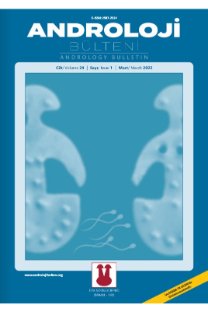Üniversitede okuyan kadın öğrencilerin cinsel mitler ile ilgili görüşleri
AMAÇ: Bu çalışmada, üniversitede okuyan kadın öğrencilerin cinsel mitler ile ilgili görüşlerinin değerlendirilmesi amaçlandı.GEREÇ VE YÖNTEM: Rastgele örnekleme yöntemiyle seçilen ve onayı alınan 157 kadın öğrenci örneklemi oluşturdu. Veriler, bireysel özellikler formu ve literatürden elde edilen verilerle, Zilbergeld tarafından geliştirilmiş 17 cinsel mitten oluşan "Cinsel Mitler Ölçeği" (CMÖ) yoluyla, araştırmacılar tarafından oluşturulan 18 adet cinsel mite ilişkin soru ile elde edildi. Mitler doğru ve yanlış olarak değerlendirildi. Verilerin değerlendirilmesinde yüzdelik, standart sapma, ortalama ve Ki-kare testi kullanıldı.BULGULAR: Araştırma kapsamına alınan 157 öğrencinin yaş ortalaması 20,5±1,5 idi. Zilbergeld tarafından geliştirilen "Cinsel Mitler Ölçeği"nin 17 cinsel mitinin onaylanma yüzdesi %46,83±15,4 (min-max: %10,2-92,4) ve bazı mitlerin onaylanma oranı (%63-92,4) oldukça yüksek bulundu. Mitlerin çoğu ile öğrencinin okuduğu bölüm, anne-baba eğitimi, gelir düzeyi, yaşadığı yer ve yaş grupları arasında anlamlı bir korelasyon saptanmadı, ancak yaşı 19 ve küçük olanların mitleri onaylama oranı daha yüksek bulundu.TARTIŞMA ve SONUÇ: Kadın öğrencilerin yaklaşık yarısının cinsel mitleri onaylama oranları yüksek bulundu. Bu durum, yeterli cinsel bilgiye sahip olunmadığının göstergesidir. Bu bağlamda, üniversitelerde tüm öğrencilere üreme ve cinsel sağlık konularında eğitim ve danışmanlık hizmeti verilebilmesinin önemli olduğu düşünülmektedir
Female university students’ opinions related to sexual myths
INTRODUCTION: In this study, our aim was to evaluate the female students’ opinions about sexual myths who study at university.MATERIAL AND METHODS: The sample constituted randomly selected 157 female students with their consent. The data were obtained through the information form about the students’ individual characteristics and the “Sexual Myths Scale” (CME), a set of 17 sexual myths developed by Zilbergeld, with questions on 18 sexual myths generated by researchers obtained from the literature. Myths were evaluated as right and wrong. Percentage, standard deviation, mean, Chi-square test were used in the evaluation of the data.RESULTS: The average age of the 157 students included in the study was 20.5±1.5. The rate of approval of 17 sexual myths by the “Sexual Myths Scale” developed by Zilbergeld was 46.83±15.4 (min-max: 10.2–92.4%) and the rate of approval of some myths (63–92.4%) were found to be quite high. There was no significant correlation among myth approval and parents’ education, income level, living place, and age groups, but students of age 19 and younger had a higher approval rate of myths.DISCUSSION AND CONCLUSION: Approximately half of the female students had a high rate of confirmation of sexual myths. This is a sign that they do not have sufficient sexual information. In this context, we believe that it is important for universities to provide education and counseling services to all students on reproduction and sexual health
___
- KAYNAKLAR
- 1. Bozdemir N, Özcan S. Cinselliğe ve cinsel sağlığa genel bakış. Turkish Journal of Family Medicine and Primary Care (TJFMPC) 2011;5:37–46.
- 2. Apay SE, Akpınar RB, Arslan S. Öğrencilerin cinsel mitlerinin incelenmesi. Anadolu Hemşirelik ve Sağlık Bilimleri Dergisi 2013;16:96–102.
- 3. Yaşan A, Gürgen F. Cinsel partneri olan bir hemşire grubu ile hiç partneri olmamış bir hemşire grubunun cinsel bilgi edinme yolları ve cinsel mitlerin yaygınlığının karşılaştırılması. Yeni Symposium 2004;42:72–6.
- 4. Ogur P, Utkualp N, Aydınoğlu N. Sağlık yüksekokulu öğrencilerinin cinsellikle ilgili inanışları. Sürekli Tıp Eğitimi Dergisi 2016;25:13–21.
- 5. Sexual health. http://www.who.int/topics/sexual_health/en/ (Erişim tarihi:16.03.2017)
- 6. Torun F, Torun SD, Özaydın AN. Erkeklerde cinsel mitlere inanma oranları ve mitlere inanmayı etkileyen faktörler. Düşünen Adam Psikiyatri ve Nörolojik Bilimler Dergisi 2011;24:24–31.
- 7. Set T, Dağdeviren N, Aktürk Z. Ergenlerde cinsellik. Gen Tıp Derg 2006;16:137–41.
- 8. Sungur MZ. Cinsel eğitim. Klinik Psikiyatri 1998;2:103–8.
- 9. Kora K, Kayır A. Cinsel roller ve cinsel mitler. Düşünen Adam Psikiyatri ve Nörolojik Bilimler Dergisi 1996;9:255–8.
- 10. Mosher DL. Sex guilt and sex myths in college men and women. Journal of Sex Research 1979;15:224–34. doi:
- 10.1080/00224497909551043
- 11. Raizada A, Gupta SB, Kumar A. Perceptions about sex related myths and misconceptions: difference in male and female. Indian Journal of Community Health 1997;9:33–8.
- 12. Lenderyou G. Sex education: a school based perspective. Sexual and Marital Therapy 1994;9:127–44.
- 13. CİSED, Cinsel Sağlık Enstitüsü Derneği. Cinsel Mitler. http:// www.cised.org.tr/sayfa146.html (Erişim tarihi:14.03.2017)
- 14. Bostancı N, Buzlu S, Tüfek F, Kalaycıoğlu D, Yıldırım N, Yılmaz S. Üniversite öğrencilerinde cinsiyete göre cinsel mitler. 6. Ulusal Hemşirelik Öğrencileri Kongresi “Uluslararası Katılımlı” Kongre Özet Kitabı; 2007. p.156.
- 15. Kapamadzija A, Bjelica A, Segedi D. Sex knowledge and behavior in male high school students. Med Pregl 2000;53:595–9.
- 16. Özmen HE. Cinsel mitler ve cinsel işlev bozuklukları. Psikiyatri Dünyası 1999;3:49–53.
- 17. İncesu C. Cinsel işlevler ve cinsel işlev bozuklukları. Klinik Psikiyatri 2004;Ek 3:3–13.
- 18. Güleç G, Kılıç Y, Bilgiç S. ESOGÜ Tıp Fakültesi birinci ve altıncı sınıf öğrencilerinde cinsel mitlerin karşılaştırılması. Osmangazi Tıp Dergisi 2007;29:136–45.
- 19. Kukulu K, Gürsoy E, Sözer AG. Turkish university students’ beliefs in sexual myths. Sex Disabil 2009;27:49–59.
- 20. Kaya F, Serin Ö, Genç A. Eğitim fakültesi birinci sınıf öğrencilerinin cinsel yaşamlarına ilişkin yaklaşımlarının belirlenmesi. TSK Koruyucu Hekimlik Bülteni. Kor Hek 2007;6:441–8.
- 21. Tuğrul C. Cinsel işlev bozukluklarının psikolojik nedenleri. Cinsel İşlev Bozuklukları Monograf Serisi 1999;2:29–33.
- 22. Apay SE, Nagorska M, Akpınar RB, Çelik AS. Student comparison of sexual myths: two-country case. Sex Disabil 2013;31:249–62.
- 23. Şahin D, Şimşek F, Seyisoğlu H. Cinsel yaşam ve sorunları. Cinsel Eğitim Tedavi ve Araştırma Derneği Yayınları; 2007. p.7–54.
- ISSN: 2587-2524
- Yayın Aralığı: Yılda 4 Sayı
- Başlangıç: 1999
- Yayıncı: Turgay Arık
Sayıdaki Diğer Makaleler
Aşırı aktif mesane semptomlarının erkek cinsel sağlığı üzerine olan etkileri
Çevresel stres faktörlerinin sperm hücreleri üzerine etkisi
EYYUP SABRİ PELİT, BÜLENT KATI, YİĞİT AKIN, ERCAN YENİ
Nüks varikosel tedavisinde mikrocerrahi varikoselektomi
AHMET GÖKÇE, H Can DİREK, Anıl ERDİK
Kronik böbrek yetmezlikli hastalarda erektil disfonksiyon ve hiperhomosisteinemi ilişkisi
Emrah SARI, Mustafa Faruk USTA
Hipospadias ve erkek cinsel sağlığı
Üniversitede okuyan kadın öğrencilerin cinsel mitler ile ilgili görüşleri
